Vol 3 No. 46 TROPIC LIGHTNING NEWS November 11, 1968
Index
Lightning And Airborne Smash NVA
CU CHI - In two days of heavy contact five miles northeast of Trang Bang,
2nd Brigade units, with elements of the 101st Airborne Division (Airmobile),
struck a smashing blow against the 101st NVA Battalion.
The 2nd Battalion, 12th Infantry White Warriors and the 3rd Battalion, 187th
Infantry, of the 101st Airborne Division killed 147 enemy during the battle.
Two companies of the White Warriors came under sniper fire on an airmobile
assault and sweep of an area where the 187th had experienced sporadic enemy
contact. In maneuvering to deal with the sniper fire, they were suddenly
exposed to the full hate of the 101st NVA Battalion. As one man put it, "all
hell broke loose."
Their advance stalled by withering fire from the enemy position, the GIs
called for close artillery and gunship support to cover their withdrawal to a
distance permitting tactical air strikes on the solidly entrenched enemy.
Then, with pinpoint accuracy, the 1st Battalion, 8th Artillery, at Fire
Support Base Pershing cleansed the area with fire. Good synchronization with
the Air Force brought their ordnance on the target a scant two minutes after the
artillery barrage lifted.
Then, late in the afternoon, the Warriors, reinforced by two companies from
the 101st Airborne, stormed into the enemy positions and pitched Charlie out.
Then the Tropic Lightning soldiers set up a night defensive position and
prepared for the expected Viet Cong counterattack.
At 1 a.m. mortars and RPGs splashed into the US position, and the North
Vietnamese assaulted all along the perimeter, sometimes so closely one White
Warrior reported throwing grenades past his own close-in gunship strikes.
After two hours the enemy reeled back, leaving 56 dead and indications that
many wounded had been dragged away. At dawn the White Warriors were resupplied
and went over to the pursuit.
Sweeping out in the morning across the area of action, the Warriors increased
their body count of 147, confirming the mutilation of the NVA Battalion.
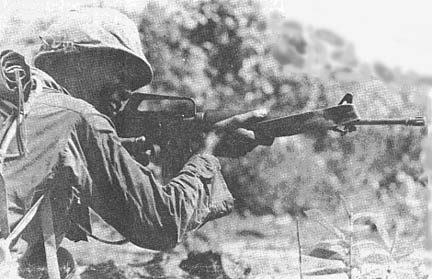 |
DEADLY BEAD - A soldier of the 2d Battalion, 12th infantry fires at a sniper during a two-day battle for the enemy-held village of Tam Dinh. The fight cost the enemy 147 dead. (PHOTO BY SP4 CHARLES HAUGHEY) |
Anniversary Turns Into Lucky Day
DAU TIENG - His first wedding anniversary proved triply lucky for Private
First Class Jerry Hunziker.
"I was celebrating by walking point for the second platoon," the Bravo
Company, 3d Battalion, 22d Infantry soldier related.
The 3d Brigade company was operating 15 miles southwest of Tay Ninh City as
Hunziker, of Drumright, Okla., approached a thick clump of bushes.
"I stepped back to ask for a machete. I flicked my weapon on automatic and
was about to spray the area to recon by fire when the lights went out."
The Regulars point man had been struck by an enemy-launched M-79 grenade
round, which failed to detonate because it apparently had not traveled far
enough to be armed.
"At first we thought he was really hurt, but then we realized he was only
stunned," said Sergeant Curtis Daniels of Deer Park, Texas.
The dazed Hunziker lay beside Daniels as the Texan fired into the brush.
They crawled several feet when Hunziker was struck again - by another unarmed
M-79 grenade.
This time the round broke the skin on the point man's right arm, and he was
evacuated by dustoff helicopter to Tay Ninh.
Recovering in base camp, the beaming infantryman said, "I must be one of the
luckiest men in Vietnam. By all odds those rounds should have gone off."
One problem continued to puzzle the Tropic Lightning soldier, however.
"My wife asked me how I'm doing and how I spent our anniversary. I won't
quite know where to begin... All I know right now is that I'm happy to be
alive."
Meanwhile, in sweeping the area, his company turned up three enemy 82mm
mortar rounds, a typewriter, a cannister full of enemy documents, 60 lbs of
salt, a gasoline lantern, and a motorcycle.
| The President of the United States has proclaimed this week as American Education Week. Why don't you look into the possibilities of furthering your education while completing your tour in Vietnam? The Education Center makes this possible. Go to your Ed. Center today. |
FSB Keene Beats Off Ground Attack,
Viet Cong's 'White Flag' Tactic Flops
CU CHI - An infantry-artillery combo from the 2d Battalion, 14th Infantry,
and the 1st Battalion, 8th Artillery, crushed a short but vigorous VC ground
attack on Fire Support Base Keene seven miles south of Cu Chi.
In the first ground assault since the units occupied the location in August,
the VC peppered the camp with 120 to 150 mortars and RPG's. The 2d Brigade
soldiers killed 13 of the attackers.
The enemy charged the wire from 3:50 a.m. until approximately 4:10 a.m. when
daylight began to cover the area.
First Lieutenant Harry D. Barnes, forward observer, recounted the start of
the battle. "They waited 'til the moon went down - exactly - to start their
attack. When it went down they started firing their RPG's.
"They tried to use bangalore torpedoes on the wire. The first ones up stuck
a white flag on the wire to mark the spot to come through. They blew the first
strand and used little bamboo ladders to come over, but it didn't do them much
good.
"They sent their sapper squads in with satchel charges, homemade shape
charges and bangalores, but most of them were killed before they did anything.
"The mortars were coming so fast at first, it was hard to return fire,"
continued Barnes.
When the mortar attack began, Specialist 4 John W. Dare from Youngston, Pa.,
ran out, grabbed a .50 caliber machine gun and opened up on the enemy.
"Then we brought in artillery, mortars and a heavy gun team. We had
illumination, and Spooky and gunships finally came to help us," said Barnes.
The cannoneers lowered their 105mm howitzers and met the charging enemy with
direct fire.
The heaviest fighting was on the southeast corner where one bunker kept the
enemy out of the wire. "We had four M-16's in one bunker on the corner of the
perimeter that did most of the work," said First Lieutenant Jerome Bevers from
Kileen, Tex., Company A's 2d Platoon leader.
The bunker was firing so heavily at the VC in the wire that shortly after the
attack began they had to call back for an emergency resupply of ammo.
Sergeant James Durrand, resupply NCO, gave them their ammo. "He didn't have
a rifle, and he had lost his steel pot," said Captain Keith Wilks, who took over
command of his company when the CO was wounded, "but that corner bunker was
getting hit pretty hard, and they were almost out of ammunition."
"Sergeant Durrand grabbed an ammo box in each hand and ran the whole way
under fire to the bunker that was engaged."
"I have no doubt," added Barnes, "that if he didn't take that ammo, they
would have overrun the wire." Bevers agreed: "If we didn't get that ammunition
we would definitely have been in a bind."
Air support from the 3d Squadron, 17th Air Cavalry, and 155mm artillery
support from the 3d Battalion 13th Artillery at Cu Chi helped thwart the attack.
| POLICE UP THE BRASS - Specialist 4 Joseph Batuska of Kansas City, Ka., cleans piled up .50 Caliber machine gun shells. He had fired more than 2,000 rounds during action southwest of Dau Tieng. (PHOTO BY SP4 DON MOUSSEAU) |
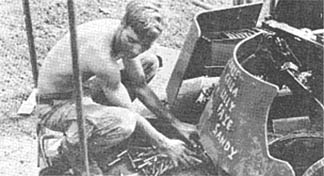 |
Page 2 TROPIC LIGHTNING NEWS November 11, 1968
Decorated
| SILVER STAR | |
|
SP4 Daniel Dunkel, Co A, 4th Bn, 23d Inf SP4 Roberto Alanis, Co A, 3d Bn, 22d Inf SP4 Douglas E. Helm, Co D, 2d Bn, 27th Inf SP4 Donald R. Wadlington, Co C, 2d Bn, 22d Inf |
PFC Willie C. Wilson, Co D, 2d Bn, 27th Inf PFC Lynn L. Pruitt, Co C, 1st Bn, 5th Inf PFC Richard J. Holman, Co B, 65th Engr Bn PFC Mark E. Reeter, B Btry, 7th Bn, 11th Arty |
| ARMY COMMENDATION MEDAL |
|
|
W02 George Grinnell, Co B, 25th Avn Bn SGT Wallace E. Douglas, HHB, 3d Bn, 13th Arty SGT Charles B. Mooney, HHB, 1st Bn, 8th Arty SGT Larry G. Outcalt, Co B, 725th Maint Bn SP5 Thomas L. Rees, Co B, 25th Avn Bn SP5 Robert E. Kent, Co A, 25th Avn En SP5 Robert A. Nissen, Hq & Co A, 725th Maint Bn SP5 Dennis G. Phillips, 25th Admin Co SP5 Charles T. Beck, B Trp, 3d Sqdn, 4th Cav SP5 Donald D. Blackmon, HHB, 1st Bn, 8th Arty SP5 Larry J. Ouret, D Btry, 3d Bn, 13th Arty SP5 James M. Flaherty, Co A, 25th Avn Bn SP4 Robert E. Lafond, Co B, 25th Avn SP4 David W. Bayler, HHB, 1st Bn, 8th Arty SP4 Phillip E. Clark, Co A, 25th Avn SP4 Kelly E. Frink, Co E, 65th Engr Bn SP4 John L. Lambus, Co A, 25th Sup & Trans SP4 Donald A. Miskanin, Co C, 65th Engr Bn |
SP4 Gerald E. Myrow, Co F, 65th Engr Bn SP4 Terry F. Reagle, HHB, 7th Bn, 11th Arty SP4 Charles H. Sailor, Co C, 65th Engr Bn SP4 Gerald Sauer, Co A, 25th Sup & Trans SP4 David R. Baumiller, Co B, 25th Sup & Trans Bn SP4 Kenneth Brendlinger, HHB, 7th Bn, 11th Arty SP4 Michael Brodinsky, 15th PID Det, 1st Bde PFC Dennis J. Kuehler, A Trp, 3d Sqdn, 4th Cav PFC Elgar R. Lewallen, Co D, 1st Bn, 27th Inf PFC Richard E. Walker, Co B, 1st Bn, 5th Inf PFC Clarence H. Wilson, B Trp, 3d Sqdn, 4th Cav PFC Robert J. MC Dougall, Co B, 1st Bn, 5th Inf PFC Marvin R. Gillming, Co B, 1st Bn, 5th Inf PFC Michael Norfleet, B Trp, 3d Sgdn, 4th Cav PFC Willie H. Porter, B Trp, 3d Sqdn, 4th Cav PFC Fernando V. Garza, Co D, 2d Bn, 27th Inf PFC Richard W. Zimmerman, B Trp, 3d Sqdn, 4th Cav PFC Charles Witty, B Trp, 3d Sqdn, 4th Cav |
Day To Remember, Veterans Day 1968
On November 11, 1918, at 5:00 am, Paris time, representatives of the
government of Germany, the most powerful of the Central Powers engaged in World
War I, signed an armistice of 35 clauses, the most severe and drastic ever
demanded from a major power.
At 11:00 am that same day, the battlefield fell silent, hostilities ended,
and for the first time in four years, the world was at peace. World War I was
over!
Historians of the time dubbed World War I as "the war to end all wars."
Those of us now in uniform know only too well that such was not the case. First
came World War II, then Korea and now Vietnam.
The strife, conflict and tension the world has endured in the intervening
fifty years may have dimmed the significance of World War I for many of us. But
November 11 is still a day to be remembered.
Until 1954, Americans celebrated November 11 as an observance of the end of
World War I. But then the Congress of the United States amplified the meaning
of the holiday, designating it Veterans Day - a day to honor all the men and
women who have served in the armed forces of the United States.
Veterans Day is a day when all Americans should pause a moment in
recollection and prayer.
By making just this simple observance before going on with our normal holiday
activities, we will have paid proper homage to the millions of Americans, past
and present living and dead, who have courageously served their country.
It is also a day for those of us who now serve - the veterans of tomorrow -
to rededicate ourselves to the principles of freedom of human dignity for which
our comrades-in-arms throughout America's history have fought and died. (AFPS)
Christmas Is Coming; Mail Soon!
It's about time you gave some thought toward mailing those Christmas gifts.
The first mailing dates have already gone by for certain types of transportation
home. The following list indicates the mailing dates recommended for fastest
service, and the types of transportation available.
Mail to CONUS. Surface mail, from 1 October to 1 November. SAM parcel mail,
from 20 November to 4 December. SAM letter mail, from 1 December to 10
December. Airmail, from 1 December to 13 December. PAL, from 1 December to 10
December.
Mail to HAWAII. Surface mail, from 15 October to 1 November. SAM parcel
mail, from 20 November to 4 December. SAM letter mail, from 1 December to 10
December. Airmail, from 1 December to 13 December. PAL, from 1 December to 10
December.
Mail to PACIFIC APO's. Surface mail, from 15 November to 4 December. SAM
parcel mail, from 20 November to 4 December. SAM letter, from 1 December to 10
December. Airmail, from 1 December to 10 December. PAL, from 1 December to 10
December.
Mail to NEW YORK APO's. Surface mail, from 1 October to 15 October. SAM
parcel mail, from 20 November to 1 December. SAM letter mail, from 1 December
to 7 December. Airmail, from 1 December to 7 December. PAL, from 1 December to
7 December.
Surface mail consists of parcels mailed at the fourth-class rate which do not
qualify as SAM mail.
SAM mail consists of parcels mailed at the fourth-class rate which do not
weigh more than five pounds or measure more than 60 inches in length and girth
combined.
PAL mail consists of parcels weighing not more than 30 pounds and measuring
not more than 60 inches in length and girth combined which will be airlifted
when the appropriate surface rate plus $1.00 fee is paid.
Length and girth combined involves measuring the longest side to get the
length. Measure the distance around the parcel at its thickest part to get the
girth. Add the length and girth.
|
Take A Hint G.I. |
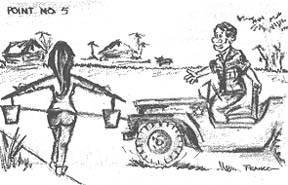 |
| No. 5 - Always give the Vietnamese the right of way. |
Write Your Army Story
The U.S. Army can help soldiers find a magazine or other periodical to
publish articles they have written about the Army.
The New York Branch of the Office of the Army Chief of Information reports
that national publications are constantly seeking interesting, distinctive and
timely feature stories.
Soldiers are encouraged to submit their stories or story ideas now. The
place to take them is an installation or unit information office.
The information officer can give soldiers guidance on subjects and clearance
procedures. (ANF)
Tropic
Lightning
Combat Honor Roll
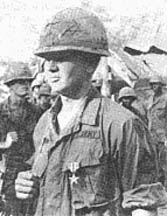 Added to the Tropic Lightning Combat Honor Roll this week is Private First Class
Archie Turner, Jr., serving with Company D, 2d Battalion, 14th Infantry.
His actions illustrate the fighting spirit of the men of Tropic Lightning.
Added to the Tropic Lightning Combat Honor Roll this week is Private First Class
Archie Turner, Jr., serving with Company D, 2d Battalion, 14th Infantry.
His actions illustrate the fighting spirit of the men of Tropic Lightning.
Turner distinguished himself by heroic actions on 20 September 1968, while
serving with Company D, 2d Battalion, 14th Infantry in the Republic of Vietnam.
While on a reconnaissance-in-force mission, his unit came under an intense
hostile attack, inflicting several casualties.
Responding immediately, Turner began placing accurate retaliatory fire on the
enemy positions, enabling his comrades to seek cover. With complete disregard
for his own safety, Turner crawled through a heavy volume of hostile fire as he
evacuated the body of a fallen comrade.
While attempting to retrieve another casualty, he was wounded and ordered to
return to friendly lines. He brought back valuable information concerning
hostile positions and the surrounding terrain.
Although he was painfully wounded, Turner refused to be evacuated to medical
treatment facilities until the remaining friendly casualties were recovered.
His valorous actions contributed immeasureably to the success of the mission and
defeat of the enemy force.
PFC Turner's personal bravery, aggressiveness and devotion to duty are in
keeping with the highest traditions of the military service and reflect great
credit upon himself, his unit, the 25th Infantry Division and the United States
Army.
The TROPIC LIGHTNING NEWS is an authorized publication of the 25th
Infantry Division. It is published weekly for all division units in the Republic of
Vietnam by the Information Office, 25th Infantry Division, APO San Francisco
96225. Army News Features, Army Photo Features, Armed Forces Press Service and Armed
Forces News Bureau material are used. Views and opinions expressed are not necessarily
those of the Department of the Army. Printed in Tokyo, Japan, by Pacific Stars and
Stripes.
MG Ellis W. Williamson . . . . Commanding General
MAJ Andrew J. Sullivan . . . Information Officer
2LT Don A. Eriksson . . . . . . Officer-in-Charge
SP4 Stephen Lochen . . . . . . Editor
SP4 Tom Quinn . . . . . . . . . . . Asst. Editor
SP4 Bill Berger . . . . . . . . . . . Production Supervisor
Page 3 TROPIC LIGHTNING NEWS November 11, 1968
Dozer Does It To Woodline
CU CHI - Clearing 25,000 square meters of heavy brush is a big job anywhere
in the world. But for 22-year-old Specialist 5 Hall Dennis of Company C, 65th
Engineer Battalion, there are special difficulties.
When the 65th Engineer Battalion in Cu Chi received the request for a
bulldozer from the 4th Battalion, 9th Infantry Manchus, who are currently
securing a forward fire support base for a 23rd Artillery Group unit three miles
north of Trung Lap, the Tropic Lightning engineers went right to work. They
began by dismantling a bulldozer in order to have it airlifted by Army Chinook
and flying crane helicopters.
After reassembly and a tank of diesel fuel, Specialist Dennis began clearing
a swatch 50 meters wide around the entire perimeter to allow the Manchu
infantrymen to string concertina wire and set up fields of fire.
Aside from the 12-hour, dawn-to-dusk day Specialist Dennis often encounters
other hardships; enemy snipers, mines and RPGs. The 100-degree-plus sun is also
a constant enemy, but the Bellflower, Calif. native is no stranger to heat.
"I like my job," says Dennis, "I know that my work is making it a little
easier for the guys who are out humping."
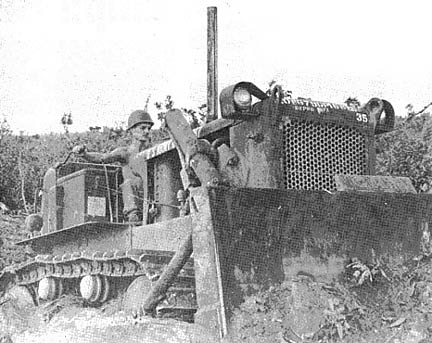 |
CLEARING THE WAY - Specialist 5 Hall Dennis, mounted aboard a bulldozer, clears the area around the night location of the 4th Battalion, 9th Infantry Manchus. Dennis, from Bellflower, Calif., is with the 65th Engineer Battalion. (PHOTO BY PFC H.J. TSCHIRNER) |
Vietnamese Kids Aid In Finding Weapons
CU CHI - The spirit of teamwork between American soldiers and local
Vietnamese civilians recently displayed itself in an unexpected way to troops of
the 3d Squadron, 4th Cavalry.
First Lieutenant Gary W. Barnes of Cincinnati, Ohio, an Alpha Troop platoon
leader, and Specialist 4 Henry R. Erber of Boyne City, Mich., were manning an
Armored Personnel Carrier (APC) securing a stretch of the main supply route (MSR)
to Tay Ninh 500 yards south of Trang Bang. From among the Vietnamese children
who stood watching the troopers from a distance, a nine-year-old boy and his
little brother signaled for their attention. With wide eyes and whirling hand
motions, the eldest boy repeated, "Beaucoup mines, big bang!"
Overcoming their suspicions Lieutenant Barnes and Specialist Erber
established security and followed the two boys to a spot 50 yards away at the
edge of a rice paddy. The two cavalrymen found half buried in the mud two
Chinese Communist 75mm recoilless rifle rounds, still packed in their shipping
cases.
The amazed and delighted troopers set a demolition charge beside the rounds
and blew them in place. Two Vietnamese kids had possibly saved the lives of
many American and ARVN soldiers.
In another incident two days later, Specialist 4 Arcadio Medina of New York,
N.Y., and Private First Class Angel M. Marin of Brooklyn, N.Y., both from the
3/4 Cav's A Troop, were outposting a section of the MSR 600 meters north of
Trang Bang. At almost the same time of day as the first incident, two small
boys approached them and tried to tell them of something buried in the mud.
When the troopers didn't follow at first, the boys turned away and ran off in
different directions.
A few minutes later, one of the boys came back lugging a 105mm howitzer
casing. The second lad then returned and indicated there was something more to
be found in the rice paddies.
Specialist Medina and Private Marin followed the boy to a spot beside Highway
6A, 750 meters from the place where the APC was parked on the MSR. There the
boy pointed to a hole in a rice paddy dike where the two soldiers found a
rocket-propelled grenade, used to knock out tanks and APCs.
The 3/4 Cav's commanding officer, Lieutenant Colonel Clemens A. Riley of St.
Louis, Mo., explained the help from the Vietnamese children. "We have been
trying to promote broad psychological operations and effective civic action
programs, and the good relations which the Cav's troopers have maintained with
the civilian population "I feel, are paying off."
Vietnamese Gets Medal For Actions
DAU TIENG - A Vietnamese interpreter for the 3d Brigade has received an
American Bronze Star Medal for valorous actions during a night battle near Tay
Ninh City.
Staff Sergeant Ngo Xuan Vinh was decorated by Lieutenant Colonel Alexander H.
Hunt of Wealder, Tex., commander of the 3d Battalion, 22d Infantry.
During the predawn hours on September 11, Vinh huddled outside a bunker,
manning a radio, while an enemy force sent a light ground probe against Fire
Support Base Buell.
As the enemy main force attacked from the north, Vinh made contact with an
ARVN outpost directly behind the attackers.
He was able to gather information about the size, location and movement of
the enemy force, enabling the Regulars to thwart the hostile advance.
In his citation, Vinh, a native of Da Nang, was cited for the "sound judgment
and highly accurate information" which he relayed to the battalion commander
during the battle.
An eyewitness to Vinh's courage Captain Donald Haramoto, the battalion
intelligence officer, praised the ARVN interpreter.
"He did a whale of a job for us that night," Haramoto said. "Sergeant Vinh
has really earned the respect of the men in our battalion. He's quite a guy."
|
Tay Ninh Children's Day Festival A Happy Time |
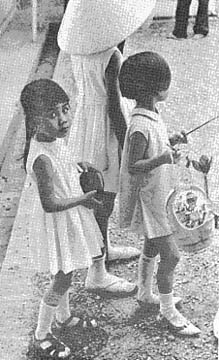 |
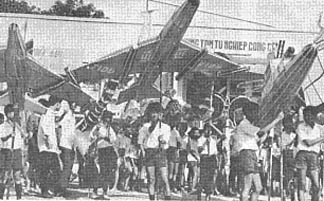 |
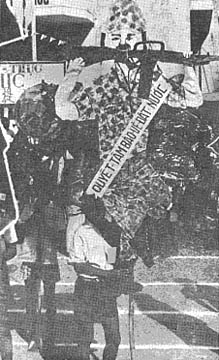 |
| COLOR AND GAIETY - Vietnamese school children from Tay Ninh City display their hand made floats as they await the judges decision in an annual Children's Day festival (Trung Thu) at province headquarters. Three young Vietnamese girls (left) put on their Sunday best to attend. They participated in a song and dance routine seen by 3,000 Vietnamese and Americans. A young Vietnamese boy (right) proudly displays his hand-made second place float after a judging contest. It is entitled "Protect Our Country". The 1st Brigade civic action section contributed 250 toys and 25 pounds of candy while the 2d Battalion, 77th Supply and Service Battalion from Tay Ninh, gave 30 pounds of ice cream. (PHOTO BY CPT LES RASCHKO) |
Page 4 - 5 TROPIC LIGHTNING NEWS November 11, 1968
Emphasis On Maintenance Keeps All Systems Go
By 1LT J. N. Black
CU CHI - The man on-line beats the bushes nearly every day. The mud and
water are facts of life to the Tropic Lightning infantryman; and it doesn't make
his job any easier.
The fighting man is only as good as his skill and equipment; and constant
attention focused on equipment maintenance will allow him to make best use of
his skills.
Maintenance is a command responsibility. But, equally important, maintenance
is a personal responsibility.
Every man is aware of his dependence on the tools of his trade, and each man
knows his own tools best.
From the mammoth rotors of the Chinook cargo helicopters to the muzzles of
the M-16s, the men who care most are the men who use them.
By stressing the care and cleaning of every piece of equipment, the U.S. Army
has kept the tools of the trade in top working condition - contributing in no
small part to the successes in Vietnam.
When the maintenance level falls, efficiency falls and accidents increase.
Particular attention to repair and care of equipment in recent months has
helped to keep the thrust of the 25th Division moving.
The tool of a mortarman may be no more than an old T-shirt; pulling the power
pack of the main battle tank may require an ensemble of machinery.
An artillery battery spends much of its time keeping the guns in good repair
and well oiled.
A deuce-and-a-half cargo truck needs water and oil daily.
From first echelon maintenance to direct exchange, it all matters.
Command Maintenance Management Inspection (CMMI) teams from the Division
Transportation Office are busy either checking for proper maintenance or
evaluating the general maintenance level within the brigades.
By their reports and findings, the maintenance of tactical units is applauded
or recommended for improvement. CM-MI gives the commander a feeling for the
maintenance in his unit and a good indication of efficiency.
Boiling it all down, it works back to the same point. When the man in the
field makes the big push that counts, he can depend on getting fire power where
and when he needs it because every piece of equipment is in top-notch
operational readiness.
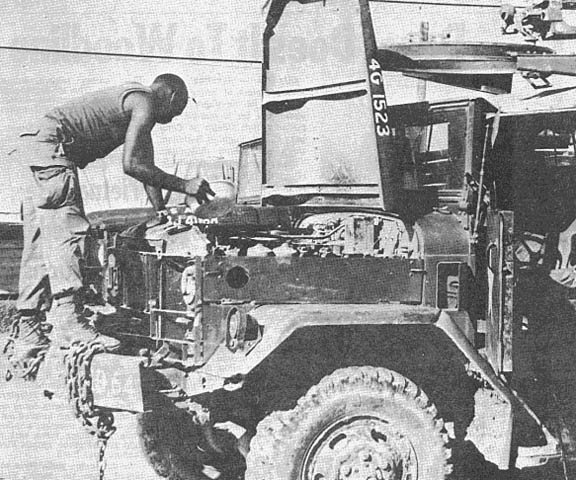 |
| DRIVER'S JOB - First echelon maintenance is part of every vehicle driver's responsibility. Sergeant Ernest Jackson, from Coleman Tex., makes minor repairs on his deuce-and-a-half. (PHOTO BY SP4 ROBERT O'HARE) |
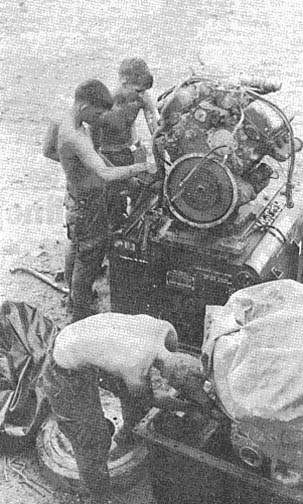 |
TEAMWORK - Among the recurring jobs for members of the armored personnel carrier crews of the 2d Battalion, 34th Armor, is the repair and lubrication of the power pack of the M-113 track vehicle. Specialist 5 Michael Trujillo of Grand Prairie, Tex., and Specialist 4 Arthur Hale of Anchorage, Alaska, complete work on the engine while Private First Class Sam Gillespie of Lincoln, Neb., does a little under cover work. (PHOTO BY SP5 GARY JOHNSON) |
| INSPECTION TIME - Specialist 5 Joseph Luke of Hartford, Conn., checks the engine compartment of his M60-A1 main battle tank in preparation for a Command Maintenance Management Inspection (CMMI) at the 2d Battalion, 34th Armor motor pool. (PHOTO BY SP5 GARY JOHNSON) |
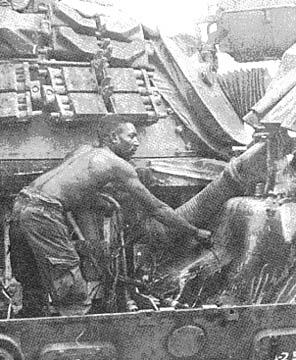 |
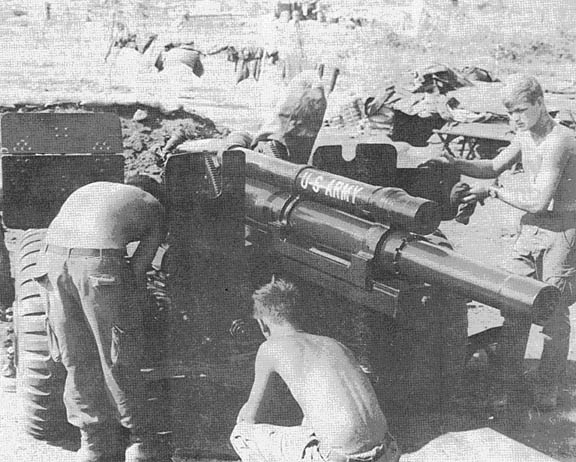 |
| READY TO FIRE - Every day is maintenance day for artillery batteries. Here cannon cockers from the 1st Battalion, 8th Artillery, give tender care to their 105 howitzer. (PHOTO BY SP5 GARY JOHNSON) |
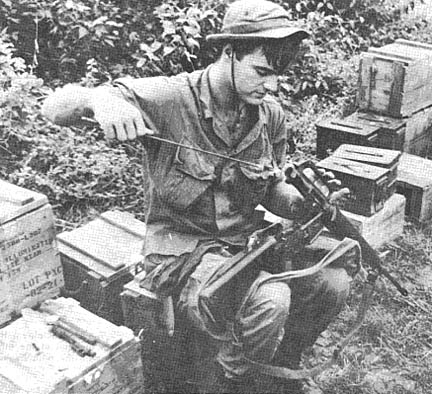 |
LOVING CARE - The ultimate weapon of the U.S. Army gets the most care - and so does his M-16. Sergeant James Calvert of Annapolis, Md., with Company C, 1st Battalion, 27th Infantry Wolfhounds, uses a cleaning rod on his rifle. (PHOTO BY SP4 ROBERT O'HARE) |
| MORNING CLEAN UP - After a night of firing support for elements of the 2d Battalion, 27th Infantry Wolfhounds, Private First Class John Banayas from Freedom, Pa., undertakes the important job of cleaning his four-deuce mortar. (PHOTO BY SP4 ROBERT O'HARE) |
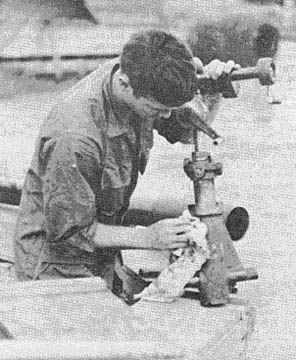 |
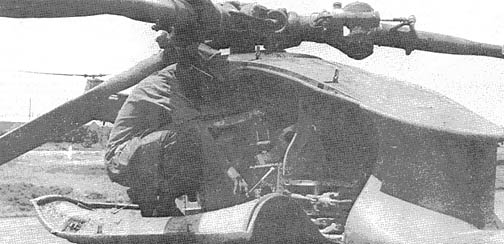 |
| PERSONAL CHECK - The pilot has to pay the hard way if something serious goes wrong. That's why every pilot must know his aircraft. Here Chief Warrant Officer John Banks of Hartwell, Ga., a Chinook pilot from the 242d Assault Support Helicopter Company, makes a personal check of the transmission before flight. (PHOTO BY SP5 GARY JOHNSON) |
Page 6 TROPIC LIGHTNING NEWS November 11, 1968
No One's Objecting To This Objector
DAU TIENG - A 3d Brigade conscientious objector has received such widespread
acclaim in the United States following his heroic actions in Vietnam, that his
name has become almost a household word.
After Specialist 5 David Chedester of Walla Walla, Wash., was presented the
Distinguished Service Cross by General Creighton Abrams, U.S. commander in
Vietnam, the story about his amazing exploits while a medic with the 3d
Battalion, 22d Infantry reconnaissance platoon made the pages of hundreds of
stateside newspapers.
Included were the Los Angeles Times, New York Times, St. Paul Pioneer-Press,
Pittsburgh Post-Gazette, his home town newspaper and many others.
The Associated Press story told of the medic's fear of war and hatred of
fighting, based on his strict faith as a Seventh Day Adventist.
Chedester received the nation's second highest award for valor for saving
more than a half dozen lives when the battalion's night defensive position
subjected to a massive ground attack last April in War Zone C.
Chedester, while mortars, rockets and RPG rocket grenades rained in all over
the perimeter, rushed to the aid of wounded comrades, treated them, brought them
to safety, and supervised their evacuation aboard dustoff helicopters.
The publicity has caused Chedester to be deluged with dozens of letters from
admirers all over the United States.
"It is reassuring to us, who only stand and wait while our sons are fighting
and dying in Vietnam, to read about someone like you," said the city manager of
a city in South Carolina. "My own son, Tim, flies C-7A Caribous out of Cam Ranh
Bay. If ever he needs help, I hope you are around. As a fellow Christian, I
pray God will look after you and return you safely to your family."
A woman from Pittsburgh wrote, "It is truly rewarding to see someone like you
and others your equal receive some amount of recognition. After reading the
article I was called upon by a little voice within me to write you. I guess you
could consider this an unusual thank you note, a note that expresses my thanks
for your bravery... God bless you not only when you sneeze, but always."
A letter without return address said, "We in the Northwest are very proud of
you. You are a brave man. My very best always."
Recently Chedester relinquished his post as reconnaissance platoon medic to
assume new duties at the battalion aid station.
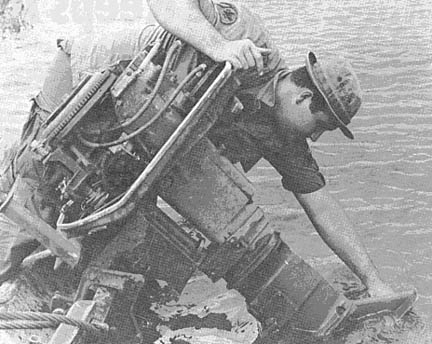 |
DAILY CARE KEEPS IT GOIN' - Even on a boat in the field Specialist 4 Bill Howard of Springfield, Ohio, can't get away from daily motor maintenance. Howard is with Company E, 65th Engineer Battalion. (PHOTO BY DAVID C. MERCER) |
Warrior Medic Shuns Fire; Saves Buddy
DAU TIENG - Crawling nearly 100 meters only inches below crisscrossing fire
from four enemy machine guns, a 3d Brigade medic rescued a critically wounded
buddy.
The action took place in the HoBo Woods, 35 miles northwest of Saigon. When
the White Warriors of the, 2d Battalion, 12th Infantry, made contact with an
enemy force in a dense jungle, their left point man was seriously wounded.
As they worked to pinpoint the location of the four rattling machine guns,
the company's senior medic, Specialist 5 Dennis R. Sheppard of North Hollywood,
Calif., began his crawl from a point near the center of the troop column.
The medic was joined by rifleman Private First Class Dennis R. Buckley of
Burbank, Calif. Together they maneuvered under withering fire.
"We moved in a zig-zag pattern for about 50 meters," said Buckley.
Reaching the injured man in knee-deep grass, Sheppard decided more help would
be needed. As Buckley returned for assistance, the unarmed medic began
administering first aid.
Gunships roared in overhead to cover the evacuation. Firing within 20 meters
of the wounded soldier, their rockets rained tiny bits of shrapnel on the
struggling medical corpsman.
Moments later three more White Warriors reached the scene. Carefully moving
the still-conscious man across 30 meters of exposed area, they reached the cover
of a hedgerow. A dustoff evacuation chopper had been summoned.
"But the situation was critical," said Sheppard. "Thus, it was necessary to
have the injured man extracted by gunship."
Within minutes the medic and his patient were inbound to the 12th Medical
Evacuation Hospital in Cu Chi.
"A lot of credit is due to the crew of that gunship," said Sheppard. "The
door gunners worked like experienced corpsmen. One of them managed the
intravenous bottle throughout the flight."
The other three riflemen who aided in the rescue are Sergeant Arthur J. Hood
of Churchrock, N.M., and Specialist 4 John M. Houck of Farockoa, Queens, N.Y.,
and Lynwood C. Keats of Gretna, Va.
2-14 Dragons Reel In Fishy Type Fisherman
CU CHI - Acting as point element of a task force designed to capitalize on
reported VC activity, the 2d Battalion, 14th Infantry Golden Dragons made an air
assault into a vast marshland near the Oriental River and hooked several
'fishermen.'
Landing in waist-deep water, the Dragons encountered the enemy almost
immediately. As Charlie Company started to sweep the area a shot was fired from
a pineapple grove on the right flank. Soon a shivering Vietnamese man emerged
with his hands above his head followed by the flanker, Private First Class Harry
Hudson of Los Angeles.
"I was walking through the pineapple when I saw two eyes staring at me just
above the surface of the water," said Hudson who was celebrating his first month
in country that day. "I fired my M-16 and up popped this fellow."
During a brief questioning by Captain Delbert L. Collins company commander,
the man claimed he was a fisherman and there were no more in the area.
The element investigated further and produced three more `fishermen' and a
small pack of documents indicating they were full-fledged local VC.
A search of the area uncovered several bunkers and fighting positions which
were then destroyed. Warm cooking fires, traps with live fish and snakes in
them, and a quantity of rice indicated the recent occupants had made a hasty
retreat as the Dragons moved in.
Bridge Opens At Phu Coung
CU CHI - For the first time since its completion, the Phu Coung bridge has
been officially opened to civilian traffic.
The span, a major link in the new Saigon by-pass, was opened to military
traffic in June.
U.S. and Vietnamese officials attended the ribbon-cutting ceremony recently
marking the opening of the span across the Saigon River.
Soldiers from the 2d Brigade are on constant alert to defend the bridge
against attack or sabotage.
Page 7 TROPIC LIGHTNING NEWS November 11, 1968
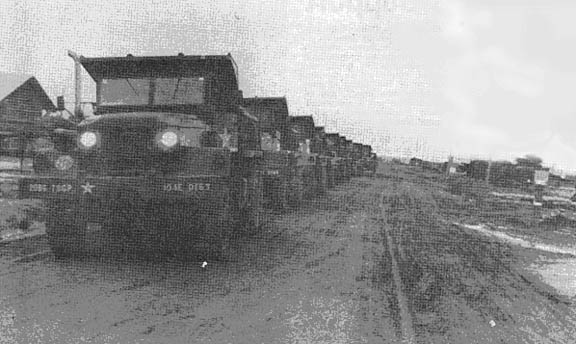 |
| READY TO ROLL - Dump trucks from the 588th Engineer Battalion roll out of Tay Ninh carrying gravel for construction of a berm line at Bau Co. One hundred thirty-five trucks carrying seven tons of gravel each were needed to build the six-foot-high berm. (PHOTO BY SP5 RICK ADAMS) |
Engrs, ARVNs, 1st Bde Bolster St. Barbara
TAY NINH - Combined operations by units of the 1st Brigade, ARVN 7th Airborne
Battalion, and 588th Engineer Battalion have greatly bolstered an American base
in the no-man's land of War Zone C.
Fire Support Base St. Barbara at Bau Co is the Tropic Lightning Division's
northern most artillery support facility, lodged alone, four miles into the
jungles above Nui Ba Den mountain.
For more than a week Bau Co was bombarded by enemy rocket and mortar
attacks. "A decision had to be made - support the camp and increase its
defenses or abandon it and pull back," observed Colonel Robert Fair, first
brigade commander.
Division infantrymen had to sweep, clear and guard the dangerous highway that
runs to Bau Co, so engineers could haul tons of equipment and supplies to
reinforce and expand the installation.
The roadway to Bau Co, hugs the base of Nui Ba Den, where VC forward
observers were stationed to call in mortars on American units using the
highway. Artillery from the 1st Brigade began pumping in as many as 2,000
rounds of explosives each day on enemy positions around the mountain and along
the highway reaching to Bau Co. American infantry and ARVN airborne troops made
air assaults and reconnaissance-in-force operations into suspected enemy
positions.
On the day of the first convoy to Bau Co, an early morning fog hugged the
ground and clung to the mountain side, refusing to burn away until noon.
Colonel Fair stated: "The fog was so thick you couldn't see nor could aircraft
fly." If the convoy moved during the fog, they could not expect artillery or
air cover.
But, Colonel Fair chose to go ahead believing the fog was just as big a
problem for the enemy. The long line of trucks struck for Bau Co.
The fog covered the convoy as it made Bau Co without enemy contact. Four Hoi
Chanhs who turned themselves in enroute, told of their battalions losing
hundreds of men during the week of concentrated American counter shellings.
Now came the job for the engineers - enlarging the fire support base. The
588th Engineers worked 24 hours a day constructing prefabricated bunkers at the
camp. They also carted more than 135 truckloads of rock and gravel for the
six-foot-high berm that would surround the enlarged portion of the base.
The engineers were charged with building an extension to the fire base to
house infantry troops.
To enlarge the fort, a mine field had to be cleared. Enemy shellings and
heavy rains had shifted the mines around so the engineers had no accurate chart
of the explosive field.
Lieutenant Colonel Coleman Clemtent, 46-year-old commander of the 588th
Engineers, explained the dangers of clearing the mine field. "It would have
been easier to run an armored personnel carrier around the field to explode the
anti-personnel mines, but we were going to have men living and working there so
we had to clear the field by hand to make sure all the mines were picked up."
Clemtent stated, "I had more volunteers than I could handle. Being an
engineer in Vietnam is not a glamorous life, but this is the type of everyday
individual courage and unassuming nature displayed by these engineers. I've
commanded the 588th Engineers for eight months and have nothing but the highest
regard and pride for the young men of today."
|
Story By SP5 Rick Adams |
| HARD AT WORK - Engineers add the finishing touches to a prefabricated bunker. The bunkers were built along the defensive berm line during the recent expansion of the 1st Brigade base four miles north of Nui Ba Den mountain. (PHOTO BY CPT LES RASCHKO) |
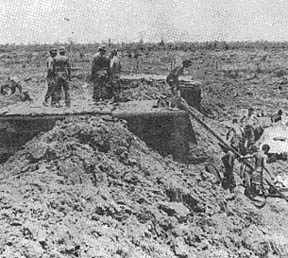 |
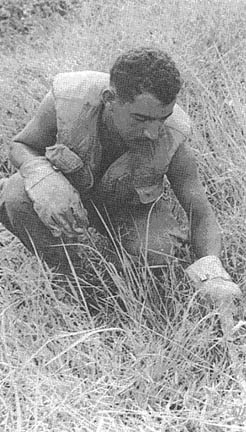 |
MINE PROBE - Specialist 4 Jose M. Negron, from Brooklyn, N.Y. with Company D, 588th Engineer Battalion uses a bayonet as he searches for mines during the reconstruction work. (PHOTO BY SP4 HERB BURDETT) |
| NEARLY FINISHED - Infantry from Company A, 3d Battalion, 22d Infantry form an assembly line to put the final touch - sandbags - on a bunker which they will occupy. (PHOTO BY CPT LES RASCHKO) |
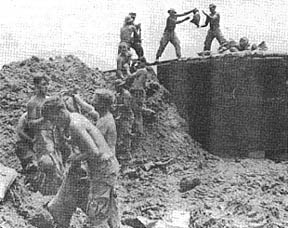 |
Page 8 TROPIC LIGHTNING NEWS November 11, 1968
White Warriors Route Enemy; Artillery And Gunships Support
CU CHI - Soldiers from the 2d Battalion, 12th Infantry White Warriors
recently engaged an estimated enemy battalion two miles northeast of Trang Bang.
The infantrymen were supported by artillery and helicopter gunships and U.S.
Air Force tactical aircraft.
At 9:30 a.m. Alpha Company came under intense enemy machine gun and automatic
weapons fire. The company was on a sweep mission in pursuit of North Vietnamese
regulars believed to be fleeing the area where 147 of their comrades died in
three days of fierce fighting earlier in the week against other units including the Warrior's Bravo Company.
Repeated efforts to neutralize the enemy's solidly entrenched positions
proved to be unsuccessful. Pulling back, the Americans called for air and
artillery strikes.
When an evening assault on the enemy stronghold stalled due to heavy
concentration of communist small arms fire, 750-pound bombs and eight-inch
artillery rounds were put into the area in an all-night barrage, leveling much
of the dense jungle.
A daybreak assault by the Alpha Company Warriors, now reinforced by Delta
Company, overran the enemy positions.
Fire and maneuver advances into the hedgerow complexes in hot pursuit of the
fleeing and beaten enemy led to the discovery of two 82mm mortars complete with
bipods, one 60-mm mortar, and a communist-made machine gun, highly prized
weapons among the Viet Cong and NVA forces.
"We hurt them pretty bad, or they would not have left those tubes behind,"
said Alpha's commanding officer, First Lieutenant Richard A. Wiggins from St.
Petersburg, Fla.
The combined air, artillery and ground operations killed 26 enemy.
| RTO - Outlined against an evening sky, a radio-telephone operator moves to his post in his unit's night defensive position. It is through the RTO the commander keeps in contact with his unit during action. (PHOTO BY SP4 ROBERT O'HARE) |
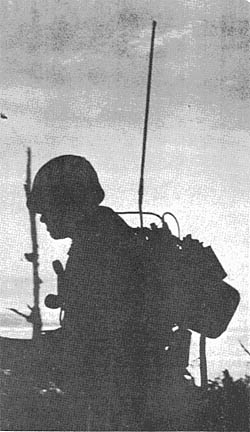 |
PSYOPS Officer's Unique Leaflet Nets A Hoi Chanh & Large Cache
CU CHI - An unusual interplay of circumstances involving the death of a VC
commander resulted in 2d Brigade soldiers receiving one of the largest caches
turned over to Tropic Lightning forces by a Hoi Chanh.
While operating in the HoBo woods northwest of Cu Chi, Delta Company, 2d
Battalion, 27th Infantry Wolfhounds encountered small arms and automatic weapons
fire from an entrenched enemy position.
To knock out the positions, the commander called in air strikes and artillery.
A sweep of the area uncovered the bodies of two VC.
It was learned that one of the two had been an officer and commander of a
company of the 7th Cu Chi Battalion.
Taking this information and a photo of the VC officer found on his body along
with a photo taken of him after he was killed, the psychological operations
officer of the 2d Brigade prepared a Chieu Hoi leaflet for air drop.
The message of the leaflet, dropped in dense VC areas, illustrated the
pointlessness of fighting Allied forces and asked if it was worth the penalty
this commander paid.
Five pays later, the leaflet drop paid off.
While combat assaulting in a nearby area, Bravo Company, 4th Battalion, 9th
Infantry, under 2d Brigade operational control, was approached by an unarmed VC
in a brown uniform.
Sergeant Fred Napier, a platoon sergeant from Bravo Company, took him in
custody while an interpreter was summoned. The VC said he wanted to turn
himself in under the Chieu Hoi Program.
Although he wasn't asked why, the Hoi Chanh gave his reason. He had seen the
leaflet with the photos of his former commander. Yes, the man pictured had been
a company commander in the 7th Battalion, but at the time of his death, he was
the battalion commander.
After asking the Americans to accept him as Hoi Chanh, he said he would lead
them to caches in the area.
The three caches he turned up included 550 CHICOM hand-grenades, 300 CHICOM
claymore mines, 200 82mm mortar rounds, 53 SKS carbines, more than 1800 rounds
of small arms ammo and 150 60mm fuses.
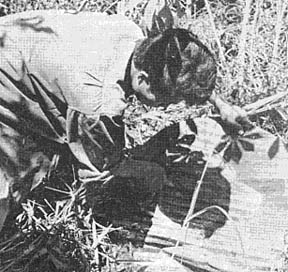 |
HOI CHANH UNCOVERS CACHE - A former VC points out the largest of three weapons and ammo caches which he revealed to Manchu soldiers from the 4th Battalion, 9th Infantry. (PHOTO BY PFC H.J. TSCHIRNER, Jr.) |
VC Suspects Untunneled
DAU TIENG, - Second Battalion, 12th Infantry White Warriors of Bravo Company
detained 11 Viet Cong suspects hidden in tunnels beneath bamboo hootches 35
miles northwest of Saigon.
With a tight cordon provided by Delta Company of the 3d Brigade unit, the
search of a small village turned up little until a Vietnamese woman was
questioned by an ARVN interpreter.
She led the infantrymen to a small tunnel beneath a cook stove. Several White
Warriors aimed their weapons at the opening as, one by one, five enemy suspects
squeezed through the 12-inch entrance.
The tunnel entrance was enlarged, and Specialist 4 John Valadez of Los
Angeles, Calif., squirmed into the musty underground chamber.
"The tunnel was very narrow, he noted. "It ran perhaps 10 meters and came to
a dead end."
About halfway in, Valadez found bundles of clothing. Near the end, he
discovered two large cloth bags containing medical equipment and supplies,
including stethoscopes, hypodermic needles, syringes, surgical instruments, and
quantities of bandages and medicines.
Similar discoveries in two other hootches in the village brought the total
enemy suspects detained to 11.
One suspect was later confirmed as a local VC medic.
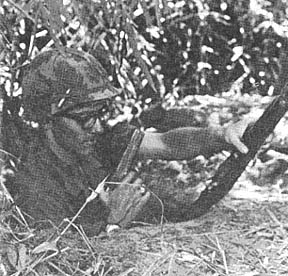 |
CANDID CAMERA - Private First Class Jay H. Hall of McConnelsville, Ohio, normally photographs the action instead of diving into it. But, while he was on a sweep with the 4th Battalion, 9th Infantry in the HoBo woods, a Hoi Chanh offered to show the Manchus three weapons caches. Hall followed the former VC into the tunnel. Hall is with the 125th Signal Battalion. (PHOTO BY PFC H.J. TSCHIRNER, JR.) |
Thanks to:
Henry Erber, A Troop, 3/4 Cavalry, for sharing this issue,
Kirk Ramsey, 2nd Bn., 14th Inf. for creating this page.
This page last modified 05-21-2007
©2007 25th Infantry Division Association. All rights reserved.